|

Designing Better Progressives
Progressives must meet the physiological needs of the
patient i.e., deliver binocularity, excellent near and distance
vision and wide clear comfortable fields of view at all distances.
To better accomplish this, new research has found
that continued reduction of blur created by unwanted astigmatism
is critical. The distance prescription affects the
placement of the near zone. In addition, the habits and
physiology of the myope is different from the emmetrope
and the hyperope.
Satisfying each type of patient requires new precision in
designing lenses that reflect the differences in the way that
each patient uses their eyes. In addition, some patients still
complain that one eye has somewhat better vision than the
other. Localized inconsistencies in the eye system, result in
less than clear vision. Therefore, to improve sight, one must
be able to measure these effects and provide methods to
be used to create a spectacle lens to globally correct them.
First, let’s review the effects of prism.
When converging, the distance prescription prism
changes the amount the eye needs to turn in to read;
myopes converge less than emmetropes, hyperopes more.
In addition, the eye of the myope is longer than the hyperope
and the shape of the retina at the point of clearest
vision is also different. This affects the location of the reading
zone and the way the surface power is managed.
Variable Inset
When looking through a prism, light is bent towards the base
of the prism, the image moves towards the apex. Since all
lenses are prisms, when the eye rotates away from the optical
axis (optical center) it looks through a prism. When reading,
the eye turns in and for a minus Rx, the eye looks
through a base in prism, for plus prescriptions, base out. As
a result, the myope converges less, the hyperope more.
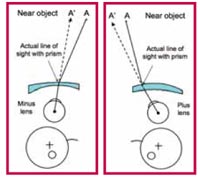 Modern progressives’ near zones have variable inset i.e.,
are designed so
that the near location
varies based
on the distance
prescription. In
minus prescriptions,
near zones
are inset less, for
plus the near is
inset more. This
results in better
reading vision
because the near zone is located where the patient is looking
and provides better binocularity (one image from two
eyes). It’s like looking through a pair of binoculars; vision is
only comfortable when both eyes are seeing the same
image. Variable inset ensures better reading comfort. Modern progressives’ near zones have variable inset i.e.,
are designed so
that the near location
varies based
on the distance
prescription. In
minus prescriptions,
near zones
are inset less, for
plus the near is
inset more. This
results in better
reading vision
because the near zone is located where the patient is looking
and provides better binocularity (one image from two
eyes). It’s like looking through a pair of binoculars; vision is
only comfortable when both eyes are seeing the same
image. Variable inset ensures better reading comfort.
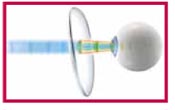 Further analysis of the effects
of astigmatism, spherical aberration
and coma, using larger
bundles of rays, over smaller
and more distinct areas of the
lens, creates a full field wavefront
that better quantifies vision needs. A new lens surface
design technology has been created using an analysis of the
wavefront effects on the total eye system. It is called Wavefront
Advanced Vision Enhancement or W.A.V.E. technology. Further analysis of the effects
of astigmatism, spherical aberration
and coma, using larger
bundles of rays, over smaller
and more distinct areas of the
lens, creates a full field wavefront
that better quantifies vision needs. A new lens surface
design technology has been created using an analysis of the
wavefront effects on the total eye system. It is called Wavefront
Advanced Vision Enhancement or W.A.V.E. technology.
W.A.V.E. Technology and Digital Surfacing
W.A.V.E.Technology provides a more precise set of directions
for designing mold or lens surfaces. Digital Surfacing,
a new manufacturing method for mold and/or lens surfaces
produces these designs with the precision needed to faithfully
replicate the design. As a result, wearers receive clearer
vision and improved contrast.

Design improvement is accomplished by better managing
how off axis astigmatism and coma affect overall vision.
Reducing off- axis astigmatism (blur) bordering the distance
and intermediate logically increases the clear field of view.
Reducing the effects of coma sharpens objects viewed off
center and improves contrast. This is especially true at
night when seeing taillights and street lamps. Improved contrast
sensitivity improves vision both day and especially at
night when vision is less discriminating.
Digital Surfacing
Had your car washed lately? Was it “drive through at the gas
station” or “detailed”? The first is inexpensive; gets rid of
the surface dirt and the gale force wind at the end blows the
car almost dry. The “detailed car” gets hand washed and
cotton swabs clean between and under. The highly polished
wax surface has blindingly clear color and won’t let anything
bad stick to spoil the look. The results cost more but are
worth every penny. “Detail” patient’s lenses by using a lab
using lenses from molds produced by digital surfacing or further
optimized by digitally surfacing the lens back surface.
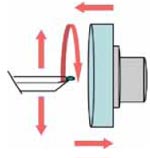 Unlike traditional processing, Digital Surfacing produces
improved progressive molds or lens surfaces more precisely.
The front surface of Varilux Physio is designed using W.A.V.E.
technology and the molds to cast
the surface are digitally surfaced.
In addition, this process can be
used to further improve vision
through progressives by optimizing
a lens back surface to reduce
any remaining unwanted optical
effects of a progressive design.
Varilux Physio 360° is the result
of a digitally surfaced back that
enhances the front Varilux Physio design. Unlike traditional processing, Digital Surfacing produces
improved progressive molds or lens surfaces more precisely.
The front surface of Varilux Physio is designed using W.A.V.E.
technology and the molds to cast
the surface are digitally surfaced.
In addition, this process can be
used to further improve vision
through progressives by optimizing
a lens back surface to reduce
any remaining unwanted optical
effects of a progressive design.
Varilux Physio 360° is the result
of a digitally surfaced back that
enhances the front Varilux Physio design.
Digital surfacing is the spinning of a mold or lens against a
single point cutter while moving the lens closer and farther
from the cutter. This results in a series of exact surface
heights required to deliver a more precise progressive surface.
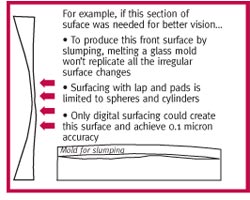 Traditionally, molds are slumped which produces a very good
approximation of the targeted design. By melting a glass blank
over a ceramic puck, which had a progressive surface cut onto
it, some of the smallest details of the surface are lost in the
slumping process; both the good and some of the bad.
Therefore, to produce
molds that replicate
better designs more
precisely, they must
be digitally surfaced.
Digital surfacing now
allows a whole library
of possibilities of
new products. Traditionally, molds are slumped which produces a very good
approximation of the targeted design. By melting a glass blank
over a ceramic puck, which had a progressive surface cut onto
it, some of the smallest details of the surface are lost in the
slumping process; both the good and some of the bad.
Therefore, to produce
molds that replicate
better designs more
precisely, they must
be digitally surfaced.
Digital surfacing now
allows a whole library
of possibilities of
new products.
For the new presbyope,
current Varilux wearer or as a progressive upgrade,
Varilux Physio as a front design, single surface progressive provides
wearers a wider clearer field of view because of reduced
coma and higher contrast. Varilux Physio 360°, front and back
design is a Varilux Physio lens whose back surface is further
optimized to improve vision by reducing any remaining unwanted
astigmatism. It provides patients with more complex prescriptions,
have had trouble with other progressives or those
that want the most accurate results, the best solution. Patient
research on Varilux Physio reports an up to 30 percent
increase in contrast sensitivity. As a major component of
vision, improved contrast sensitivity makes vision more precise,
is safer for the individual in situations where quick thinking
is a must and can reduce eye fatigue and stress.
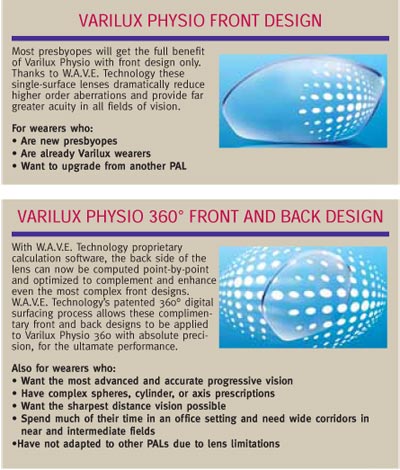
Dual Adds Through Digital Surfacing
 Digital surfacing can reduce the unwanted errors of progressives
by placing a portion of the add power on both surfaces
of the lens. In this way, the amount of astigmatism or blur is
reduced for any add power and vision overall in the lens is
improved. For example, the amounts of astigmatism or blur
in a +1.25 add and +0.75 add together is less than the blur
created in a +2.00 add progressive. In this way, a 2.00 add
Definity progressive provides better overall vision for wearers
when compared to other
lenses. A dual add approach
results in a wider intermediate
with reduced distortion.
The design of the near has
Ground View Advantage, a
reduction of power at the
bottom of the
near. This provides
clearer vision
when looking down
or may help when
walking down
stairs. Digital surfacing can reduce the unwanted errors of progressives
by placing a portion of the add power on both surfaces
of the lens. In this way, the amount of astigmatism or blur is
reduced for any add power and vision overall in the lens is
improved. For example, the amounts of astigmatism or blur
in a +1.25 add and +0.75 add together is less than the blur
created in a +2.00 add progressive. In this way, a 2.00 add
Definity progressive provides better overall vision for wearers
when compared to other
lenses. A dual add approach
results in a wider intermediate
with reduced distortion.
The design of the near has
Ground View Advantage, a
reduction of power at the
bottom of the
near. This provides
clearer vision
when looking down
or may help when
walking down
stairs.
New Harmonix Technology & Accolade
Precision for Eye Shape Differences
As we described earlier, the ametropia and the resulting prescription
changes the design requirements for lenses. New
research teaches that the myope has a longer eye than the hyperope,
the retina is also steeper and therefore, the way that the
power is distributed on the lens surface affects the way that the
patient comfortably uses the lens. In addition, to make the lens
more useful to the
patient, adjusting
the zone sizes and
customizing the
placement of the
near for any frame
chosen makes
sense.
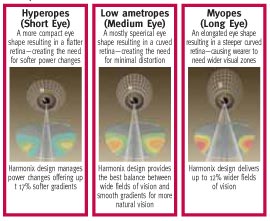 New Harmonix
Technology from
Essilor considers
the differences in
eye shape and provides lens designs that automatically meet
each patient’s physiological needs. The myope’s longer eye;
this results in a steeper retina farther from the lens. As a
result, the image from a section of the lens is distributed over
a steeper arc (more area) so the effects of surface power
changes are less disturbing to the wearer. The longer eye
radius and minification effects make the myope use more of
the lens surface so would benefit from wider zones of clear
vision. The hyperope is the opposite. Because the eye is shorter
and the image on the retina must fit a smaller area, power
changes occur faster and may be more disturbing to the wearer.
As a result, hyperopes benefit from softer gradients, which
are less disturbing. The increased magnification effect also
makes hyperopes head turners and a softer gradient improves
overall comfort. New Harmonix
Technology from
Essilor considers
the differences in
eye shape and provides lens designs that automatically meet
each patient’s physiological needs. The myope’s longer eye;
this results in a steeper retina farther from the lens. As a
result, the image from a section of the lens is distributed over
a steeper arc (more area) so the effects of surface power
changes are less disturbing to the wearer. The longer eye
radius and minification effects make the myope use more of
the lens surface so would benefit from wider zones of clear
vision. The hyperope is the opposite. Because the eye is shorter
and the image on the retina must fit a smaller area, power
changes occur faster and may be more disturbing to the wearer.
As a result, hyperopes benefit from softer gradients, which
are less disturbing. The increased magnification effect also
makes hyperopes head turners and a softer gradient improves
overall comfort.
The result is a new lens called Accolade that adjusts the
design of the progressive for the eye shape of the wearer to
improve comfort and vision.
Designs Automatically Optimized for
Frame and Patient
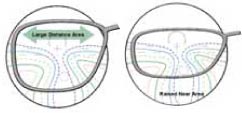 Digital surfacing can also free the optician from some of the
limitations of “minimum fitting height” requirements. The
design of the progressive is adjusted for the frame size chosen,
fitting height required, prescription and what is known
about the visual characteristics of wearer. In
new Accolade Freedom, eye and frame
shape are considered when the prescription
is created. The design is changed to
improve distance area in
large frames and shorten
the corridor in smaller
frames, all automatically.
Precision fit and an automatic adjustment
of the design creates an optimal
result for patients, optimizing frame size,
PD and fitting height while providing the optician
the ability to give patients a more personalized progressive.
It also allows the optician the ability to reduce the
number of progressives that need to be considered. In a
world of so many wonderful and competing designs, this
simplifies the task but automatically includes the latest
design and manufacturing technologies. Digital surfacing can also free the optician from some of the
limitations of “minimum fitting height” requirements. The
design of the progressive is adjusted for the frame size chosen,
fitting height required, prescription and what is known
about the visual characteristics of wearer. In
new Accolade Freedom, eye and frame
shape are considered when the prescription
is created. The design is changed to
improve distance area in
large frames and shorten
the corridor in smaller
frames, all automatically.
Precision fit and an automatic adjustment
of the design creates an optimal
result for patients, optimizing frame size,
PD and fitting height while providing the optician
the ability to give patients a more personalized progressive.
It also allows the optician the ability to reduce the
number of progressives that need to be considered. In a
world of so many wonderful and competing designs, this
simplifies the task but automatically includes the latest
design and manufacturing technologies.
Next Steps
Think increased personalization for other lenses as well.
Digital surfacing will make new designs possible for single
vision and computer lenses. Get ready.
{Sponsored by Essilor of America and Luxottica Group}
www.varilux.com • www.crizalpro.com • www.luxottica.com
|
